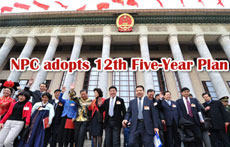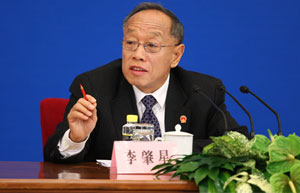Full text: Report on China's economic, social development plan
(Xinhua)
Updated: 2011-03-18 15:00
4. We will accelerate industrial restructuring, and focus on enhancing core competitiveness.
1) We will vigorously stimulate independent innovation and the development of strategic emerging industries. We will conduct research and formulate a plan for improving independent innovation capacity and a national medium- and long-term program for developing major science and technology infrastructure. We will intensively advance the Knowledge Innovation Program, the Technology Innovation Program and major science and technology infrastructure projects; accelerate the implementation of key science and technology programs; and carry out national pilot projects and demonstrations for innovation-oriented cities. We will quickly formulate and implement a development plan and supporting policies for strategic emerging industries, set up a special fund for promoting their development, expand the scale of venture capital investment in them, formulate a guiding list for developing them, and work out industry standards for major emerging industries. We will organize the implementation of industrial innovation and development projects, including those on National Broadband Internet Agenda, cloud computing, the Internet of Things, integrated circuits, flat-panel displays, space infrastructure, regional aircraft and industrialization of general aviation aircraft, as well as major application and demonstration projects on the health of the people and on using information technology to benefit the people. We will advance national pilot programs and demonstrations for IT promotion.
2) We will actively transform and upgrade traditional industries. We will continue to implement the plan for restructuring and invigorating key industries, and promulgate and implement a new guiding catalog for industrial restructuring. We will strongly support technological upgrading in enterprises. We will actively make adjustments to the allocation of the productive forces in key industries, including steel, petrochemicals, non-ferrous metals and ship-building. We will speed up the development of modern industrial clusters of equipment manufacturing, auto parts, textile and other light industries. We will stimulate restructuring and upgrading in the food industry, strengthen food safety monitoring capabilities, and improve our ability to ensure food safety. We will guide enterprise mergers and reorganizations, and raise the level of industrial concentration. We will set up a sound policy framework for phasing out backward production facilities, continue to shut down backward production facilities at thermal power plants, steel mills, iron foundries, cement plants, paper mills, plate glass plants and other industrial enterprises in accordance with the law, and start the trial of replacing small coal-fired furnaces with combined heat and power facilities. We will expedite the development of public service infrastructure for small and medium-sized enterprises, expand their funding channels, and create a favorable environment for their development.
3) We will accelerate the development of the service sector. We will continue to carry out trials of comprehensive reforms in the service sector, establish demonstration areas of clustered development of producer services, and make innovations in the pattern of development of consumer services. We will focus on developing services oriented toward rural areas, accelerate development of high-tech services closely linked with modern manufacturing, and vigorously develop emerging services. We will broaden financing channels for service enterprises, and quickly reduce electricity, water, gas and heating rates for service enterprises encouraged by the state to the same level as those paid by industrial enterprises. We will actively work to turn Hainan into an international tourist island. In 2011, it is projected that the number of urban community service facilities will reach 185,000, an increase of 2.2%. We will speed up development of information and communications infrastructure; extend the country's optical cables to 10.95 million kilometers, 1 million kilometers more than last year; and raise the number of broadband Internet access ports to 223 million, an increase of 35 million.
4) We will strengthen the development of the modern energy industry and the comprehensive transport system. We will actively push for the transformation of the methods of energy production and use, and build a modern energy industrial system that is safe, stable, economical and clean. We will accelerate mergers and reorganizations of coalmining enterprises, and carry out the development of large coalmining bases and large and medium-sized modern coalmines in an orderly manner. We will strengthen the development of large oil and gas production bases and improve the pattern of the refinery industry. We will vigorously develop renewable energy sources and promote the development and use of new energy sources. In 2011, raw coal output is projected to grow 4.9%, crude oil output will remain basically at the present level, and natural gas output will increase 10.1%. Total electricity generation will increase 8%, including 6.1% and 13.3% increases in hydropower and nuclear power respectively, and the installed power-generating capacity of on-grid wind power facilities will increase 45%. We will speed up the development of important transportation routes and integrated transportation hubs; give priority to the construction of passenger railway lines, trunk railway lines in the western region, national expressways, national and provincial trunk highways, the main navigation channel on the Yangtze River, high-grade inland waterways, ports and regional airports in the central and western regions, and main airports in the western region; and improve road maintenance. In 2011, the total length of railways and highways opened to traffic throughout the country will reach 99,000 kilometers and 4.1 million kilometers, up 8.8% and 3% respectively. This includes 13,000 kilometers of high-speed railways and 83,000 kilometers of expressways, increases of 4,700 kilometers and 9,000 kilometers respectively. The total length of high-grade navigable inland waterways will reach 10,400 kilometers, 400 kilometers longer than last year. The number of airports opened to air traffic will come to 181, an increase of 6.



